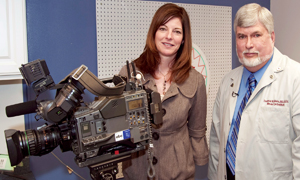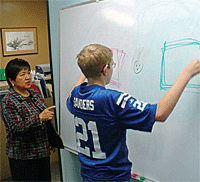
Dominick Maino, O.D., M.Ed., with ABC WLS-TV Healthbeat Segment Producer Christina Tressel. Dr. Maino was featured on the program discussing undiagnosed vision problems discovered in the wake of recent 3-D movie releases.
In addition to serving as a Professor of Pediatrics and Binocular Vision at the Illinois College of Optometry’s Illinois Eye Institute and as the editor of Optometry & Vision Development, Dominick Maino, O.D., M.Ed., is considered an expert on the subject of 3-D vision syndrome and its treatment.
Dr. Maino is also in private practice with Denice Rice-Kelly, O.D., and Cheryl Adams, O.D., at Northwest Optometric Associates in Harwood Heights, Ill.
The Chicago affiliate of ABC News recently interviewed Dr. Maino in wake of the wave of 3-D movies now hitting theaters.
Movies such as “Avatar,” “Alice in Wonderland” and “How to Train Your Dragon” have left many viewers experiencing headaches, nausea, dizziness, diplopia and eyestrain.
These could be signs of undiagnosed vision problems, according to Dr. Maino.
“Anywhere from 3 million to 9 million or more individuals will have binocular vision dysfunction that will stop them from enjoying 3-D movies,” said Dr. Maino. “Watching 3-D movies can unmask issues such as lazy eye or convergence insufficiency.”
Patients may present with asthenopia, in which they cannot specifically describe the problem but know that something is just not right.
Dr. Maino stressed that optometric vision therapy can help with these problems and that it’s quite effective even for adults.
“The goal is to improve eye coordination, focusing and eye movement to help with the appreciation of the 3-D experience,” he said. “We need to re-educate the brain to achieve single, clear, comfortable, two-eyed vision so that everyone can appreciate these new technologies.”
Dr. Maino points out that the human organism was not designed to act in a virtual 3-D environment. This can cause a cognitive dissonance in which what someone knows to be true (the image is at the distance of the movie screen) and sees to be true (the distance they actually perceive the image to be) are in conflict.
“After optometric vision therapy they can start trusting what they see,” said Dr. Maino.
The Illinois Eye Institute provides binocular vision services to thousands of patients each year.
Since the segment aired on ABC News, Dr. Maino said he has received e-mails from all over inquiring about optometric vision therapy. He has directed these patients to the Dr. Locators on the AOA and the College of Optometry in Vision Development Web sites (www.aoa.org and www.covd.org).
Dr. Maino suggests that optometrists who are not familiar with the techniques of diagnosing binocular vision disorders review the AOA Optometric Clinical Practice Guidelines on Pediatric Eye and Vision Examination (available at http://www.aoa.org/documents/CPG-2.pdf).
The procedures for screening for convergence insufficiency are available at http://www.aoa.org/documents/PLRG-CI-Card.pdf.
Dr. Maino has recently published two articles that may be helpful for other practitioners.
A Review of Optometry article on neuroplasticity speaks to working with adults who have binocular vision dysfunction (http://www.revoptom.com/continuing_education/tabviewtest/lessonid/106025/).
The second one, from Optometric Management, is on binocular vision dysfunction and is available at http://www.optometric.com/article.aspx?article=103756.
“We have an epidemic of undiagnosed and untreated binocular vision problems that optometrists should diagnose, treat or refer out for treatment.” said Dr. Maino.
Dr. Maino also notes the best way for a primary eye care practice to provide state-of-the-art care for those with binocular dysfunction is to hire someone who specializes in pediatrics and binocular vision problems, such as those who have completed a residency in this area.
He also suggests visiting his blog, http://mainosmemos.blogspot.com/, for the latest information on children’s vision.


